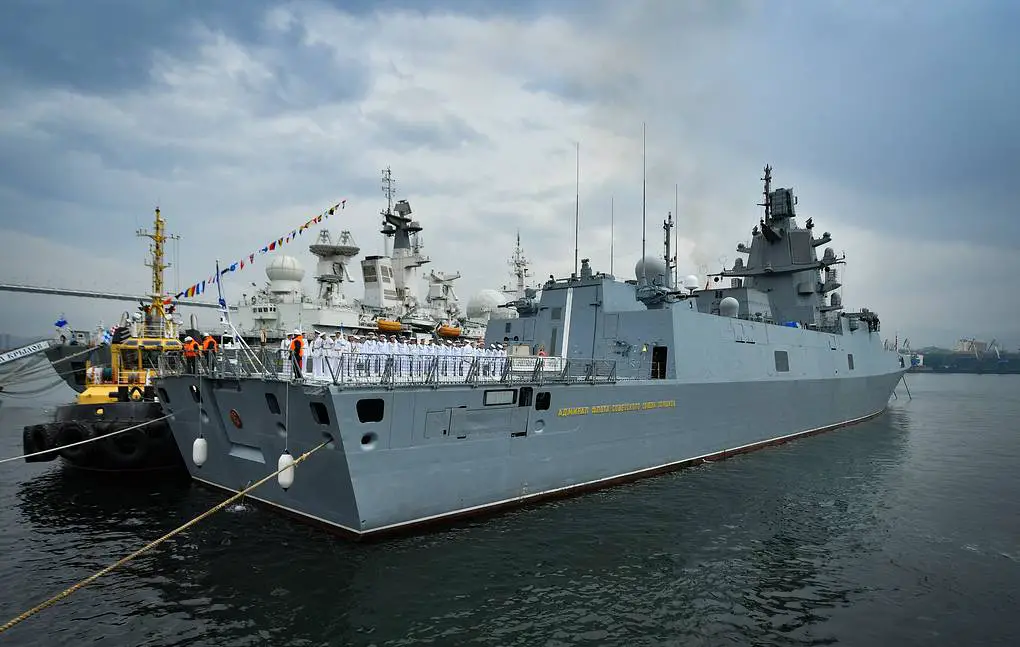Russian Navy strength insufficient to promote SSBN combat sustainability - take 2
The Russian nuclear submarines with ballistic missiles (SSBN) regularly sail for combat duty to the open ocean. The range of modern ballistic missiles can reach any point of the globe from the naval base. However, at the base SSBN are clearly visible for satellites of potential adversaries and are vulnerable to a preventive strike. It is easier for them to hide in the World Ocean and deliver a guaranteed retaliation strike. Stealth characteristics are important, but they do not fully guarantee a complete SSBN invulnerability, the Military-Industrial Courier writes.
 Russia's Admiral Gorshkov frigate (Picture source: TASS)
Russia's Admiral Gorshkov frigate (Picture source: TASS)
As the Navy strength is insufficient to promote SSBN combat sustainability in oceans, the only way out is to deploy SSBN in areas close to the Russian coast where they can feel relatively safe due to the complicated hydrology, shallow waters and closeness to naval bases.
The most convenient deployment places for the Northern fleet are the east of the Barents Sea and the Arctic Ocean. However, navigational conditions are difficult there (in Soviet years the title of the Hero of the Soviet Union was awarded to nuclear submarines for sailing from the Northern to the Pacific fleet). Besides, the limited space makes it possible for a sufficient antisubmarine force to detect and destroy SSBN. The shallow waters allow massively engaging mines. In some cases, it will be necessary to surface from under the ice for a missile strike.
For the Pacific fleet, the only convenient combat patrol area is the shallow waters in the Sea of Okhotsk.
Naturally, it is possible to deploy major reconnaissance means in the areas and patrol SSBN deployment areas by other submarines, etc. However, it is difficult to detect a noiseless nuclear submarine in conditions of difficult hydrology and under the ice. Besides nuclear submarines, the potential adversary can engage diesel-electric subs which confirmed effectiveness at Joint Task Force Exercise 06-2 in December 2005 to hunt Russian SSBN. The Swedish Gotland submarine conditionally destroyed a US nuclear submarine which protected a group of warships led by the Ronald Reagan aircraft carrier and then attacked surface warships and sank the aircraft carrier. In 2003, the Gotland defeated the US and French nuclear submarines. The Australian Collins and the Israeli Dolphin-class submarines also broke through the antisubmarine defence of the US aircraft-carrying group.
Future threats include unmanned underwater vehicles which will operate in the areas of Russian SSBN deployment. In this case, stealth characteristics will guarantee survivability. However, as patrol areas are relatively small and the noise is sufficiently high, and the adversary will engage sufficient antisubmarine forces, it would be impossible to ensure SSBN combat sustainability without protection by other naval forces.
The conclusion is simple. It is necessary to increase the number of surface warships, nuclear and diesel-electric submarines, as well as naval aviation in the area. However, no such growth is envisaged. The conclusion is distressing. If a nuclear war is not waged from the beginning, the Russian Navy will definitely lose over half of SSBN. It will weaken the retaliatory strike and give a chance to the adversary to win.
Adversary SSBN will not encounter major resistance from Russian antisubmarine forces, will not sustain big losses and will be able to fire a major salvo.
In case of an armed conflict, the Russian SSBN will be locked in waters which are useless for effective combat because of the relief, small depth, ice and complicated hydrology. It will complicate the detection of nuclear and diesel-electric submarines of the adversary and the engagement of missile arms, the Military-Industrial Courier said.


























